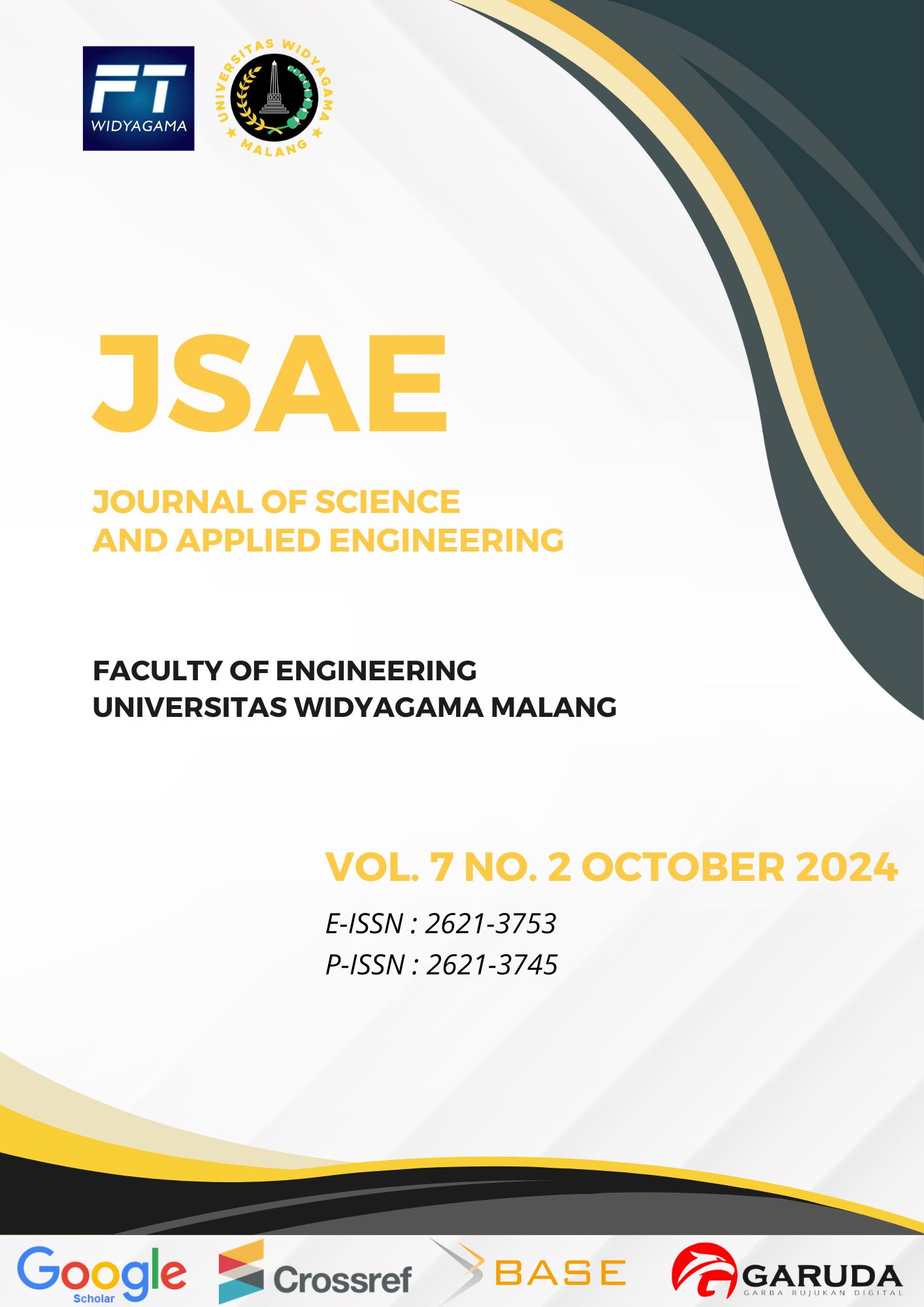THE INFLUENCE OF CaCl₂, ZnCl₂, AND Na₂CO₃ ACTIVATORS ON THE IODINE ADSORPTION CAPACITY OF ACTIVATED CARBON FROM CAESALPINIA SAPPAN WOOD
DOI:
https://doi.org/10.31328/jsae.v7i2.6560Keywords:
Activated carbon, Iodine adsorption, Caesalpinia sappan, ZnCl₂, CaCl₂, Na₂CO₃Abstract
This study aims to evaluate the influence of three chemical activators, namely CaCl₂, ZnCl₂, and Na₂CO₃, on the iodine adsorption capacity of activated carbon derived from Caesalpinia sappan wood. This wood was chosen for its high lignocellulosic content and antioxidant-rich brazilin, which may facilitate the production of highly porous activated carbon. The activation process was carried out using a reactor with varying concentrations of activators, and iodine adsorption capacity was tested according to ASTM-D4607-14 standards. The results revealed that ZnCl₂ exhibited the highest iodine adsorption capacity compared to CaCl₂ and Na₂CO₃, with a maximum adsorption capacity of 1123 mg/g at a 1-gram ratio. This study demonstrates that the choice of activator significantly influences the characteristics and adsorption capacity of activated carbon, which has potential applications in water and gas purification.References
[1] J. H. Li, S. L. Yang, N. Sun, and L. Ma, “Study on the Preparation of Activated Carbon From Corncobs,” Advanced Materials Research. 2013.
[2] D. Y. Purwaningsih, A. Budianto, A. A. Ningrum, and T. Kosagi, “Produksi Karbon Aktif Dari Kulit Singkong Dengan Aktivasi Kimia Fisika Menggunakan Gelombang Mikro,” Semin. Nas. Sains dan Teknol. Terap. VII, pp. 663–670, 2019.
[3] M. Sun, Q. Wang, and H. Di, “A review of lignocellulosic biomass-based shape-stable composite phase change materials,” J. Energy Storage, vol. 73, no. PD, p. 109114, 2023.
[4] M. R. A. Syamsunarno, R. Safitri, and Y. Kamisah, “Protective Effects of Caesalpinia sappan Linn. and Its Bioactive Compounds on Cardiovascular Organs,” Front. Pharmacol., vol. 12, no. September, pp. 1–14, 2021.
[5] S. Rawal, B. Joshi, and Y. Kumar, “Synthesis and characterization of activated carbon from the biomass of Saccharum bengalense for electrochemical supercapacitors,” J. Energy Storage, vol. 20, no. October, pp. 418–426, 2018.
[6] L. Zhang, Z. Dong, L. Wang, and C. Xu, “Effects of CaCl2 on Concentration and Speciation of Soil Cd Around a Pb-Zn Mine,” Iop Conf. Ser. Earth Environ. Sci., vol. 1087, no. 1, p. 12057, 2022.
[7] E. R. Chaldun, D. G. S. Andayani, and T. Handayani, “Physicochemical properties of sodium alginate from brown algae Sargassum aquifolium and Sargassum cinereum,” IOP Conf. Ser. Earth Environ. Sci., vol. 1201, no. 1, 2023.
[8] L. Yin et al., “Adsorption of Three Flavonoids From Aqueous Solutions Onto Mesoporous Carbon,” J. Chem. Eng. Data, vol. 62, no. 10, pp. 3178–3186, 2017.
[9] D. Saha et al., “Studies on Supercapacitor Electrode Material From Activated Lignin-Derived Mesoporous Carbon,” Langmuir, vol. 30, no. 3, pp. 900–910, 2014.
[10] Y. Li, S.-X. Hou, Q. Wei, X. Ma, and Y. Qu, “Effect of Alkali and 1,4-Butanediol Contents on the Extraction of Lignin and Lignin-Based Activated Carbon,” Acs Omega, vol. 6, no. 50, pp. 34386–34394, 2021.
[11] D. Vargas, L. Giraldo, and J. C. Moreno–Piraján, “Calorimetric Study of Activated Carbons Impregnated With CaCl2,” Open Chem., vol. 13, no. 1, 2015.
[12] Z.-H. Wang, H. Liu, Z. Fang, X. Zhou, and X. Long, “Production of Isophthalic Acid From M‐Xylene Catalyzed by Co(II) and HPW@C Modified With ZnCl2 Solution,” Can. J. Chem. Eng., vol. 97, no. 7, pp. 2086–2096, 2019.
[13] N. S. Topcu, G. Duman, H. Olgun, and J. Yanık, “Evaluation of Poultry Manure: Combination of Phosphorus Recovery and Activated Carbon Production,” Acs Omega, vol. 7, no. 24, pp. 20710–20718, 2022.
[14] R. Kumar and C. Namasivayam, “Zinc Chloride-Activated Jatropha Husk Carbon for Removal of Phenol From Water by Adsorption: Equilibrium and Kinetic Studies,” Toxicol. Environ. Chem., vol. 93, no. 6, pp. 1111–1122, 2011.
[15] T. Van Tran, “PREPARATION OF ACTIVATED CARBON FROM SUGARCANE BAGASSE USING ZnCl2 FOR THE REMOVAL OF Cu (II) ION FROM AQUEOUS SOLUTION: APPLICATION OF RESPONSE SURFACE METHODOLOGY (RSM),” Vietnam J. Sci. Technol., vol. 54, no. 1A, p. 277, 2018.
[16] H. Demiral and I. Uzun, “Preparation and Characterization of Activated Carbons From Poplar Wood (Populus L.),” Surf. Interface Anal., vol. 42, no. 6–7, pp. 1338–1341, 2010.
[17] D. Cendekia, D. Afifah, and W. Hanifah, “Linearity graph in the prediction of granular active carbon (gac) adsorption ability,” in Iop Conference Series Earth and Environmental Science, 2022, vol. 1012, no. 1, p. 12079.
[18] J. Zhou, P. Dong, and S. Guo, “Experimental study of the waste gas of coil removing iodine,” Adv. Mater. Res., vol. 518–523, pp. 1936–1941, 2012.
[19] C. Saka, “BET, TG–DTG, FT-IR, SEM, Iodine Number Analysis and Preparation of Activated Carbon From Acorn Shell by Chemical Activation With ZnCl2,” J. Anal. Appl. Pyrolysis, 2012.




